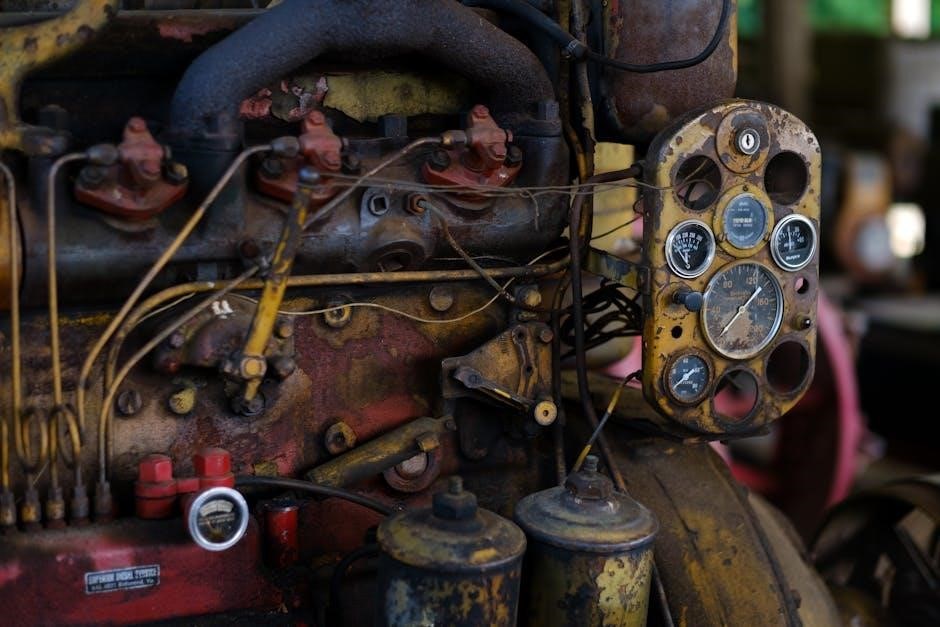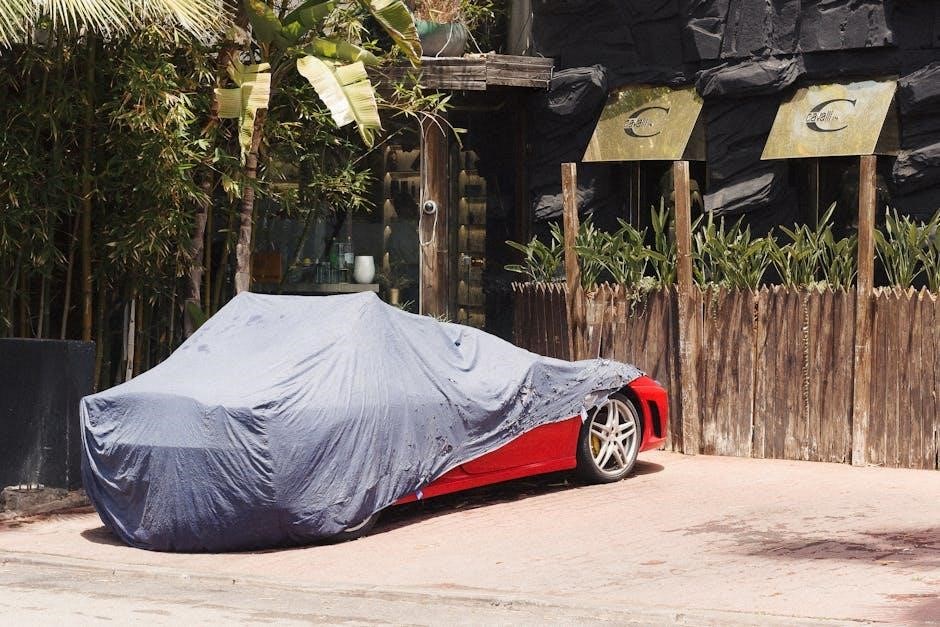
Understanding Trolling Motor Wiring Basics
A trolling motor electrical system involves batteries, wires, and connections that power the motor. Understanding these basics ensures safe and efficient operation on the water.
A trolling motor electrical system consists of batteries, wiring, and connections that power the motor. These systems are typically 12V, 24V, 36V, or 48V, depending on the motor’s voltage rating. Proper wiring ensures safe and efficient operation, while incorrect connections can lead to malfunctions or safety hazards. Understanding the basics, such as battery configurations, wire gauges, and circuit protection, is essential for maintaining reliability and performance. Always follow manufacturer guidelines and use high-quality components to avoid electrical issues on the water.
Importance of Proper Wiring for Safe Operation
Proper wiring is critical for safe and reliable trolling motor operation. Incorrect connections can lead to short circuits, electrical fires, or motor damage. Ensure all wires are correctly sized and insulated to handle the system’s current. Proper wiring also prevents battery drain and ensures consistent power delivery. Always follow manufacturer guidelines and use high-quality materials to avoid safety hazards. Correct installation protects both the motor and the boat’s electrical system, ensuring a safe and enjoyable fishing experience;
- Prevents short circuits and electrical fires.
- Ensures consistent power delivery.
- Protects the motor and battery system.
- Reduces risk of safety hazards on the water.

Step-by-Step Guide to Wiring a 24V Trolling Motor
Wiring a 24V trolling motor involves connecting dual 12V batteries in series, installing a plug, and ensuring proper wire gauge for safe and efficient operation.
Preparing the Necessary Tools and Materials
To wire a 24V trolling motor, gather essential tools and materials. You’ll need two 12V deep-cycle batteries, a battery connector cable, marine-grade wire, and a trolling motor plug. Include a multimeter, wire strippers, crimping tools, and heat-shrink tubing for secure connections. Don’t forget a circuit breaker, voltage meter, and protective gloves. Ensure all materials are marine-rated to withstand harsh conditions. Having everything ready simplifies the process and ensures a safe, efficient installation.
Connecting Dual 12V Batteries in Series
To create a 24V system, connect two 12V batteries in series. Attach the positive terminal of the first battery to the negative terminal of the second using a heavy-duty connector cable. This setup doubles the voltage while maintaining the same capacity. Ensure polarity is correct to avoid damage or safety hazards. Use marine-grade cables and secure connections with crimped or soldered joints. This configuration powers the trolling motor efficiently, providing the required voltage for optimal performance on the water.
Installing the Trolling Motor Plug and Receptacle
Install the trolling motor plug and receptacle securely to ensure a reliable electrical connection. Strip the motor wires and attach them to the plug’s terminals, using terminal crimpers for a secure fit. Mount the receptacle near the battery, ensuring it’s easily accessible. Connect the appropriate wires from the receptacle to the battery, following proper polarity. This setup allows easy motor removal and prevents electrical issues, ensuring safe and efficient operation while on the water. Always follow manufacturer guidelines for installation.
Trolling Motor Wiring Diagrams and Schematics
Trolling motor wiring diagrams provide clear illustrations for connecting batteries, wires, and accessories. They outline voltage-specific setups (12V, 24V, 36V, 48V) and ensure safe, efficient electrical connections.
Interpreting 24V Trolling Motor Wiring Diagrams
Understanding 24V trolling motor wiring diagrams is essential for correct installation. These diagrams show how to connect dual 12V batteries in series, ensuring proper voltage and polarity. Positive terminals connect to negative terminals of the next battery, creating a 24V system. Color-coded wires and symbols indicate live, ground, and control connections. Always follow the diagram to avoid short circuits and ensure safe, efficient power delivery to the motor.
Understanding Battery and Motor Connections
Proper battery and motor connections are critical for a 24V trolling motor system. Dual 12V batteries are connected in series, with the positive terminal of one battery linked to the negative terminal of the other. This configuration ensures the correct voltage is delivered to the motor. Always maintain proper polarity to avoid short circuits. Use high-quality connectors and wires to minimize resistance. Regularly inspect connections for corrosion or damage to ensure reliable and safe operation of your trolling motor system.
Choosing the Right Wire Gauge for Your System
Selecting the appropriate wire gauge is crucial for your trolling motor system. The correct gauge ensures safe current flow and efficient power delivery to the motor.
Calculating the Correct Wire Size for Your Setup
To ensure safe and efficient operation, calculating the correct wire size for your trolling motor involves assessing the maximum current draw and the distance between components. Start by determining the motor’s maximum amperage, typically found in the specifications. Next, measure the total length of the wire needed, considering both the positive and negative cables. Use a wire gauge chart to select a wire that can handle the current without excessive voltage drop. For trolling motors, a common recommendation is to use 8 AWG or 6 AWG wires for systems up to 30 amps. Thicker wires may be necessary for higher currents or longer runs. Always opt for high-quality materials, such as marine-grade copper wires, to ensure durability and conductivity. Proper connections and circuit protection, like fuses or circuit breakers, are also crucial to prevent overheating and damage. By carefully selecting the appropriate wire size, you can maintain reliable performance and safety on the water.
Importance of Using High-Quality Wiring Materials
Using high-quality wiring materials is essential for ensuring the reliability and safety of your trolling motor system. Marine-grade copper wires are recommended for their durability and conductivity, reducing the risk of voltage drop and overheating. Proper insulation and protection against moisture and temperature fluctuations are critical to prevent electrical failures. Investing in superior wiring materials ensures consistent performance, protects your investment, and enhances overall safety while operating your trolling motor on the water.
Safety Precautions and Best Practices
Installing circuit breakers and fuses protects against overloads and short circuits. Ensure proper polarity and disconnect the motor before any maintenance to ensure safety.
Installing Circuit Breakers and Fuses
Installing circuit breakers and fuses is essential to protect your trolling motor system from power surges, overloads, and short circuits. Always use a circuit breaker rated for your motor’s maximum current. Mount it near the battery to ensure quick disconnection in emergencies. Fuses act as a safeguard, blowing when excessive current flows. Properly connect all wires, ensuring secure terminals. Test the system after installation and inspect regularly for wear or damage. This ensures reliable performance and prevents potential hazards while on the water.
Protecting Against Overload and Short Circuits
Protect your trolling motor system from overloads and short circuits by installing circuit breakers and fuses. These devices interrupt power during surges or overcurrent events, preventing damage. Use appropriately rated components to handle your system’s current safely. Regularly inspect wiring for wear or damage to avoid unexpected issues. Proper protection ensures the longevity and reliable operation of your motor and batteries, safeguarding your investment and ensuring safe boating experiences.

Advanced Trolling Motor Wiring Techniques
Explore advanced wiring methods for 36V and 48V systems, including lithium battery integration. These techniques enhance efficiency and power output for high-performance trolling motor setups.
Wiring for 36V and 48V Systems
For 36V and 48V trolling motor systems, multiple 12V batteries are connected in series. A 36V setup typically uses three 12V batteries, while a 48V system requires four. Proper wire gauge selection is critical to handle increased current demands. Use marine-grade wires to ensure durability and safety. When wiring, always connect positive terminals to negative terminals in sequence, maintaining correct polarity to avoid short circuits. Install a circuit breaker to protect against overloads. Ensure all connections are secure and insulated for reliable performance.
Using Lithium Batteries with Your Trolling Motor
Lithium batteries, particularly LiFePO4, are ideal for trolling motors due to their high efficiency and longevity. They can be wired similarly to traditional 12V batteries but require specific charge settings. For 24V systems, connect two lithium batteries in series. Ensure your charger and trolling motor are compatible with lithium technology. Always follow manufacturer guidelines to prevent overcharging and ensure safe operation. Proper installation and maintenance will maximize performance and lifespan of your lithium-powered trolling motor system.
Troubleshooting Common Wiring Issues
Identify short circuits, power loss, or motor malfunction by checking connections and wires. Use a multimeter or test light to locate faults. Ensure all terminals are secure and clean.
Identifying and Fixing Short Circuits
To identify a short circuit in your trolling motor wiring, turn off the motor and disconnect the battery. Use a multimeter to test for continuity between wires. A short circuit will show no resistance. Inspect wires for visible damage, corrosion, or loose connections. Repair or replace damaged wires, ensuring proper insulation. Verify polarity to avoid incorrect connections. Once fixed, reconnect the battery and test the motor at a low speed to ensure proper operation.
Diagnosing Power Loss or Motor Malfunction
Diagnosing power loss or motor malfunction involves checking connections, battery voltage, and wiring integrity. Start by ensuring all terminals are clean and secure. Use a multimeter to verify battery voltage and test for continuity in the wiring. If power loss occurs, inspect for loose or corroded connections. Check the trolling motor plug and receptacle for damage. Consult a wiring diagram to trace the circuit and identify any breaks or short circuits. Addressing these issues promptly ensures reliable motor performance and extends system lifespan.

Minn Kota Trolling Motor Specific Wiring Guide
Minn Kota trolling motors require precise wiring for optimal performance. Use the provided wiring diagrams to ensure correct connections for power, speed, and direction control. Always follow the manufacturer’s guidelines for installing plugs, connectors, and circuit breakers to maintain safety and efficiency. Proper wiring ensures reliable operation and extends the lifespan of your motor.
Wiring Diagrams for Minn Kota Motors
Minn Kota wiring diagrams provide clear guidelines for connecting batteries, motors, and accessories. These diagrams outline the specific wire colors and terminal connections for different models, ensuring proper installation. They detail how to link batteries in series for 24V or 36V systems and how to integrate accessories like foot pedals or remotes. Following these diagrams ensures safe, efficient operation and prevents electrical issues. Always refer to the official Minn Kota manual for accurate and model-specific instructions.
Tips for Troubleshooting Minn Kota Systems
When troubleshooting Minn Kota systems, start by checking battery connections and wire integrity. Ensure all terminals are secure and free from corrosion. Verify proper voltage using a multimeter. If the motor doesn’t respond, inspect the foot pedal or remote for issues. Check circuit breakers or fuses to rule out overloads. Consult the wiring diagram to trace connections. If problems persist, refer to the Minn Kota manual or contact authorized service for assistance.

Motorguide Trolling Motor Specific Wiring Guide
Proper wiring for Motorguide trolling motors ensures reliable performance. Use the provided diagrams to connect batteries and components correctly, following voltage and wire gauge recommendations for optimal functionality.
Wiring Diagrams for Motorguide Motors
Motorguide trolling motor wiring diagrams provide clear visual guides for connecting batteries, terminals, and components. These diagrams outline specific wire colors, gauges, and terminal connections, ensuring proper setup for 12V, 24V, or 36V systems.
- Use the diagram to identify positive and negative terminals.
- Ensure correct wire gauge for current demands.
- Follow polarity to prevent short circuits and damage.
Referencing the diagram ensures safe and efficient installation, preventing electrical issues and enhancing motor performance.
Tips for Troubleshooting Motorguide Systems
Troubleshooting Motorguide trolling motor systems starts with checking connections and wiring. Common issues include loose terminals, incorrect wire gauge, or polarity reversal.
- Verify battery voltage matches the motor’s rating.
- Inspect wires for damage or corrosion.
- Check circuit breakers and fuses for tripping.
Consult the wiring diagram to ensure all connections are correct. Testing voltage at key points can identify power loss or short circuits, ensuring reliable motor operation and preventing further damage.